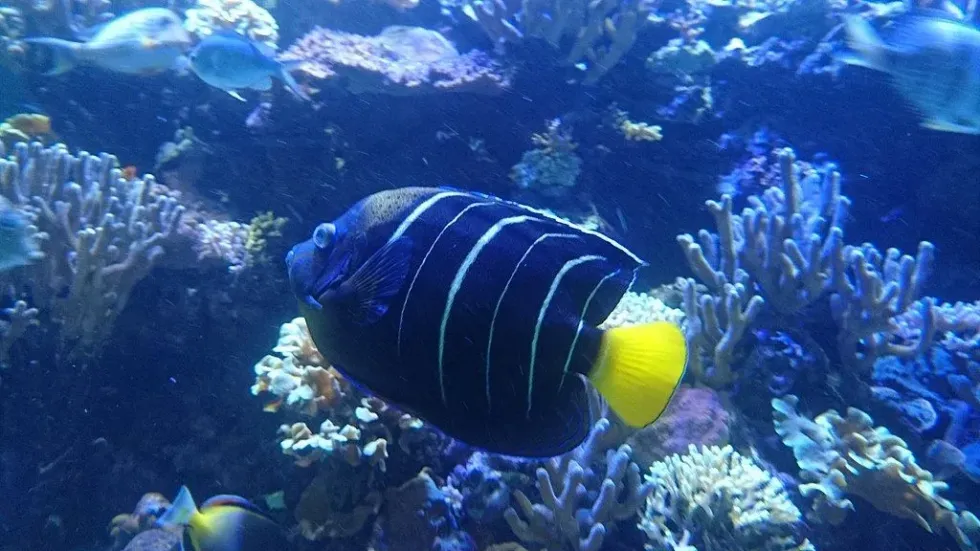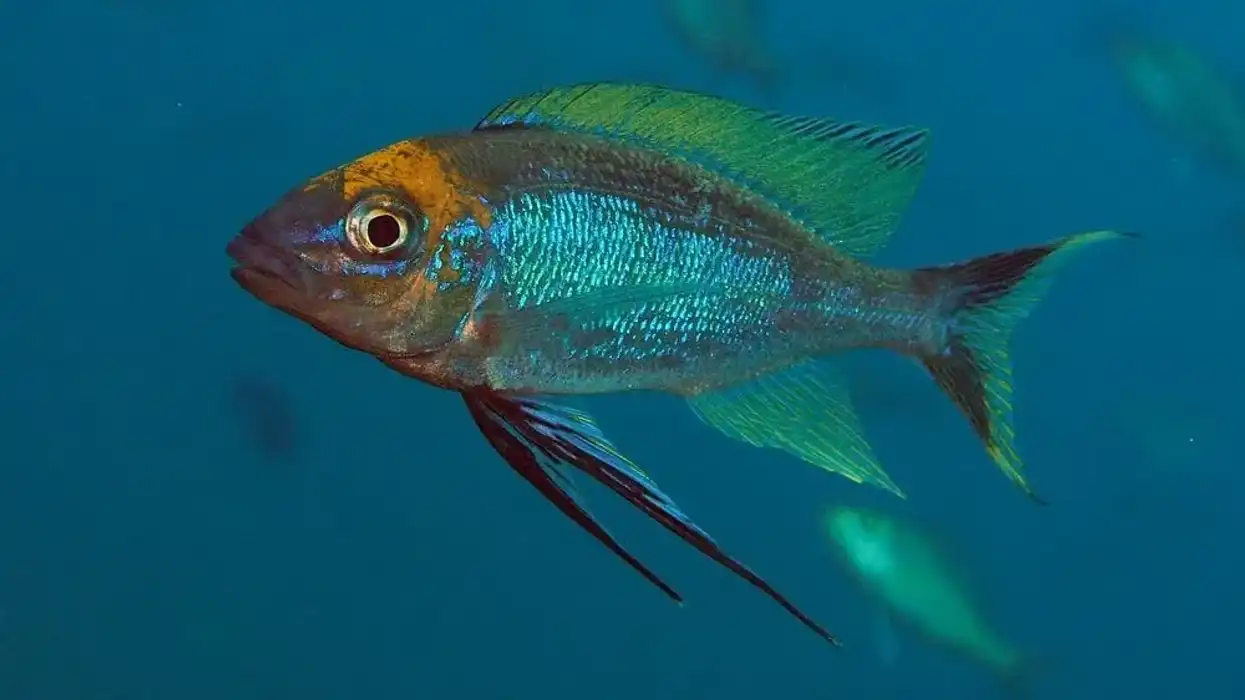The goldtail angelfish is a species of angelfish from the genus Pomacanthus. It gets its common name from its golden-yellow tail. Its range covers the western Indian Ocean, near the coasts of eastern Africa and the Gulf of Aden.
Its range also covers Madagascar and the Seychelles. It lives in shallow marine waters among shallow rocky reefs and among soft corals. Goldtail angelfish live for 15-20 years and most of those are spent alone.
It is black-blue in color with many white vertical bars. It also has striking blue stripes on its head.
It feeds on sponges, crustaceans, and zooplankton and gets preyed on by larger fish, barracudas, and probably sharks. The goldtail angelfish is a species of Least Concern according to the IUCN and its population trends are stable too. It is also not very popular as a pet fish in personal aquariums or tanks.
For more relatable content, check out these Buenos Aires tetra fun facts and round goby facts for kids.
Goldtail Angelfish Interesting Facts
What type of animal are goldtail angelfish?
The goldtail angelfish (Pomacanthus chrysurus) is a fish.
What class of animal do goldtail angelfish belong to?
The goldtail angelfish (Pomacanthus chrysurus) species belongs to the Actinopterygii (ray-finned fish) class of animals.
How many goldtail angelfish are there in the world?
The exact number of goldtail angelfish (Pomacanthus chrysurus) in the world is unknown, but there are no major threats to the species. These angelfish are very common and abundant within their habitat range with stable population trends.
Where do goldtail angelfish live?
Goldtail angelfish (Pomacanthus chrysurus) occur in the western Indian Ocean, from the coasts of eastern Africa to the Gulf of Aden. Their range also encompasses KwaZulu-Natal, the Comoro Islands, Madagascar, and the Seychelles.
What is a goldtail angelfish's habitat?
Goldtail angelfish (also known sometimes as ear spot angelfish) are found in the marine waters of the western Indian Ocean, in shallow reefs, rocky reefs, and among corals. This species of fish is found between depths of 3.3-98.4 ft (1-30 m), near a given coral reef.
Who do goldtail angelfish live with?
Goldtail angelfish (also known as ear spot angelfish) live solitary lives. Juveniles of the goldtail angelfish species tend to be seen in groups though.
How long do goldtail angelfish live?
These Pomacanthus chrysurus angelfish live for 10-15 years.
How do they reproduce?
Pomacanthus chrysurus angelfish may spawn near a coral reef site during winter. A single male may mate with four females and goldtail angelfish are protogynous hermaphrodites. Therefore, when the male leaves the group, one of the females turns into a male.
After mating, 300-500 eggs are laid by females at the nest site. These eggs float for one to three days before hatching into larvae. Adulthood is reached between 6-12 months of age.
What is their conservation status?
The conservation status of the goldtail angelfish (Pomacanthus chrysurus angelfish) species according to the International Union for Conservation of Nature is Least Concern.
Goldtail Angelfish Fun Facts
What do goldtail angelfish look like?
Juveniles and adults of the Pomacanthus chrysurus angelfish species show more similarities than other angelfish of the Pomacanthus genus. Juveniles tend to have blackish-brown coloration with vertical white bars.
The face of a juvenile is paler and much more orange than its body. The face also has uneven blue-colored lines on it. Adults and juveniles both have a white spot on the anterior upper part of their bodies and the faces of the adults are dark.
The dorsal fin has 17-19 soft rays and 13-14 spines, whereas the anal fin has 18-19 soft rays and three spines. Goldtail angelfish also have eponymous golden-yellow tails and sapphire blue stripes on their heads.

How cute are they?
Pomacanthus chrysurus angelfish are one of the cutest fish in the ocean. They have broad, flat bodies that are a beautiful black-blue color. They have really small and cute fins and gorgeous 'golden' tails. They also have striking sapphire blue stripes on their heads and vertical white bars on their bodies.
How do they communicate?
Like other angelfish, Pomacanthus chrysurus angelfish are able to convey their breeding status through the chemical signals that are present in their urine as well as their bile. Also, during times of distress, goldtail angelfish make a clicking sound.
How big is a goldtail angelfish?
The goldtail angelfish (Pomacanthus chrysurus angelfish) can be as long as 13 in (33 cm), which makes them about nine times bigger than black phantom tetras.
How fast can a goldtail angelfish swim?
It is unclear how fast goldtail angelfish can swim, but they are generally considered to be slow swimmers.
How much do a goldtail angelfish weigh?
Goldtail angelfish can weigh up to 2 lb (0.9 kg).
What are the male and female names of the species?
Males and females of the goldtail angelfish species do not have specific names.
What would you call a baby goldtail angelfish?
A baby goldtail angelfish can be called a fry or a juvenile.
What do they eat?
In their wild habitat, goldtail angelfish eat sponges, crustaceans, zooplankton, tunicates, algae, small marine plants, and other marine animals. Their predators include larger fish, barracudas, and sharks.
Are they poisonous?
No, goldtail angelfish are not poisonous. They may be aggressive with some other fish though.
Would they make a good pet?
Yes, they make decent pets but they are only mildly popular in the fish pet market. Most of the goldtail angelfish that are sold in the fish industry come from Kenya.
Goldtail angelfish require a tank size of 220 gal (1,000 L) at least. The water current in the tank should be low and there should be live rocks in the tank for the purpose of grazing. They like to nip at soft and stony coral and at clam mantles.
Did you know...
The black phantom angelfish is the rarest angelfish. It is found in northern regions of the Philippines.
Angelfish use their flat pancake-like bodies to get away from predators through coral reef crevices and holes. Some angelfish use their coloration to camouflage themselves within the soft corals in a reef site.
And some have a sharp spine on their gills that may be used to stab an attacker or to wedge themselves into tight spaces in the reef.
Angelfish are not deadly to humans, but most angelfish tend to be aggressive towards each other, whether at a breeding site or when feeding.
The average lifespan of the blue angelfish is around 20 years.
Different types of angelfish
There are two main types of angelfish: freshwater angelfish of the genus Pterophyllum (family Cichlidae) and marine angelfish of the family Pomacanthidae. The Pterophyllum genus consists of three different angelfish: the altum angelfish, Leopold's angelfish, and the freshwater angelfish (Pterophyllum scalare).
The marine angelfish family Pomacanthidae consists of eight different genera containing 88 different species, which include the goldtail angelfish and the French angelfish.
Naming goldtail angelfish
The 'goldtail' part of this fish's name comes from having golden-yellow tails. Angelfish are called 'angelfish' since their fins look a little like an angel's wings. They also cast an angel-like silhouette when their heads are down.
Here at Kidadl, we have carefully created lots of interesting family-friendly animal facts for everyone to discover! Learn more about some other fishes from our golden tetra fun facts and pigfish fun facts for kids pages.
You can even occupy yourself at home by coloring in one of our free printable goldtail angelfish coloring pages.









